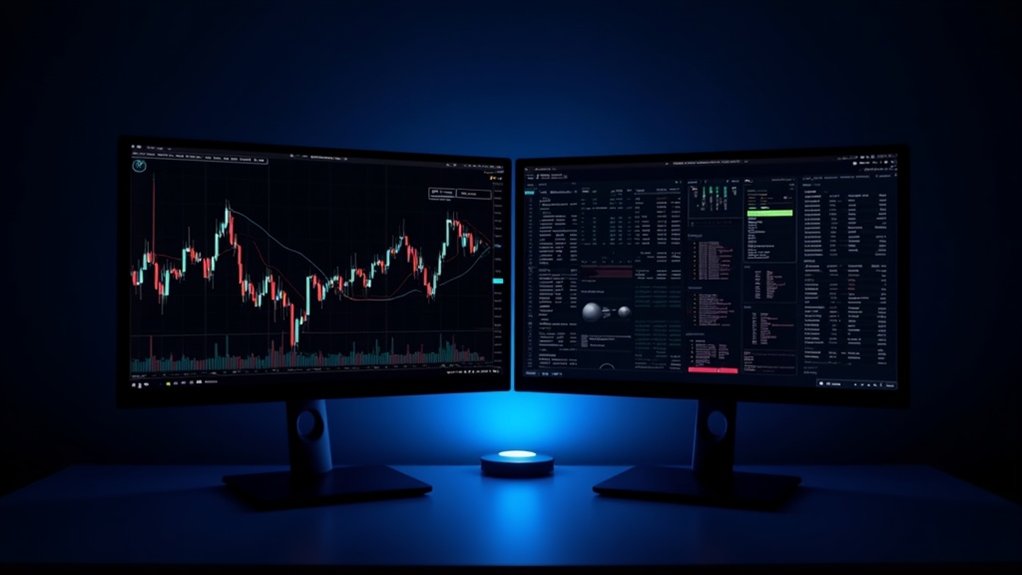Crypto arbitrage trading exploits price differences of the same cryptocurrency across exchanges. Traders buy low on one platform, sell high on another. Simple concept, tricky execution. It comes in various forms: spatial (between exchanges), triangular (three currencies), and statistical (algorithm-based). Success requires serious capital, custom algorithms, and lightning-fast execution. Not for the average Joe. Big players dominate this game with sophisticated tech. The profit opportunities vanish in milliseconds—blink and you’ll miss the money train.
Why are some traders making effortless profits while others struggle to stay afloat in the volatile crypto market? The answer might lie in crypto arbitrage trading. It’s not rocket science. Buy low on one exchange, sell high on another. Pocket the difference. Simple, right?
Crypto arbitrage capitalizes on price discrepancies across different exchanges. Unlike traditional stock markets with centralized pricing, cryptocurrency markets are fragmented. The same Bitcoin might cost $40,000 on Binance but $40,300 on Coinbase. That’s free money waiting to be grabbed. These differences emerge because each exchange operates independently with its own supply, demand, and liquidity pools. When a whale dumps a massive sell order on one platform, prices dip there before others catch up. Smart traders pounce on these moments.
The fragmented crypto market offers free money to those who spot exchanges selling identical assets at different prices.
Several flavors of arbitrage exist. Spatial arbitrage involves cross-exchange trades. Triangular arbitrage exploits price differences between three cryptocurrencies on a single exchange. Statistical arbitrage uses algorithms and historical data to predict price movements. Options arbitrage? That’s for the math nerds who understand volatility spreads. Interest rate arbitrage allows traders to profit by borrowing at lower rates on one platform and lending at higher rates on another. Some traders combine arbitrage with derivative contracts to hedge against potential price swings during trades.
Bots dominate this game now. Humans simply can’t compete with algorithms monitoring price feeds across dozens of exchanges simultaneously. These programs execute trades in milliseconds, capturing profits before most traders even notice the opportunity. The windows close fast. Really fast.
It’s not all rainbows and lambos, though. Fees eat profits. Network congestion delays transfers. Regulatory hurdles complicate matters. By the time your Bitcoin arrives at the second exchange, the price gap might have vanished. Or worse, reversed. Many ambitious arbitrage traders have learned expensive lessons this way.
Market volatility creates these opportunities but also amplifies risks. Large capital requirements present another barrier. The biggest players run sophisticated operations with dedicated servers and custom algorithms. For the average trader, it’s like bringing a knife to a gunfight. Swift execution is critical to successfully capitalize on price differences before they disappear.
Still, arbitrage remains one of cryptocurrency’s most consistent profit strategies for those equipped to execute it properly.
Frequently Asked Questions
Is Crypto Arbitrage Trading Legal in All Countries?
No, crypto arbitrage trading isn’t legal everywhere. The legality depends entirely on a country’s stance toward cryptocurrencies generally.
While it’s permitted in the US, Canada, and most of Europe, some Asian and Middle Eastern nations have outright bans.
Even where it’s legal, traders must navigate a maze of KYC and AML requirements.
The regulatory landscape is constantly shifting too. What’s allowed today might be banned tomorrow. Compliance isn’t optional.
What Are the Tax Implications of Crypto Arbitrage Profits?
Crypto arbitrage profits don’t escape the tax man. Period. Most countries treat them as capital gains or business income, depending on trading frequency.
Short-term gains? Higher tax rates, usually. The paperwork’s a nightmare—every transaction across exchanges must be recorded with dates, amounts, and fees.
Miss something? Prepare for penalties. Tax authorities are getting smarter about crypto tracking too.
No hiding those sweet arbitrage profits anymore. The government always wants its cut.
How Much Capital Do I Need to Start Arbitrage Trading?
Crypto arbitrage trading requires substantial capital. Industry pros recommend at least $100,000 to generate meaningful profits after fees and slippage. Profits per trade? A measly 0.05-0.15%. Do the math.
Many traders start with 10-20% of their intended capital before scaling up.
There’s also the $5,000-$15,000 needed for infrastructure – trading bots, data feeds, API integration.
And don’t forget $5,000-$10,000 for legal and tax consultations. Not exactly pocket change.
Can Arbitrage Opportunities Be Automated With Trading Bots?
Yes, crypto arbitrage can absolutely be automated with trading bots. These digital workhorses monitor multiple exchanges simultaneously, spotting price differences in milliseconds. They execute trades faster than any human could dream of.
No bathroom breaks, no emotional decisions. Just cold, hard algorithms. Many traders rely on bots for spatial, triangular, and cross-border arbitrage.
Not foolproof though. Technical issues, API limits, and high competition from other bots can still mess things up.
How Do Exchange Withdrawal Limits Affect Arbitrage Strategies?
Exchange withdrawal limits throw a wrench in arbitrage strategies.
They cap how much traders can move between platforms, forcing smaller transactions that eat into profits with multiple fees. Fully verified users get higher limits, but that means more KYC hoops to jump through.
Timing gets messed up too—withdrawals can take minutes or hours while prices change.
Pretty hard to capitalize on a 2% spread when you’re stuck waiting for your funds to clear.
Frustrating? Absolutely.








